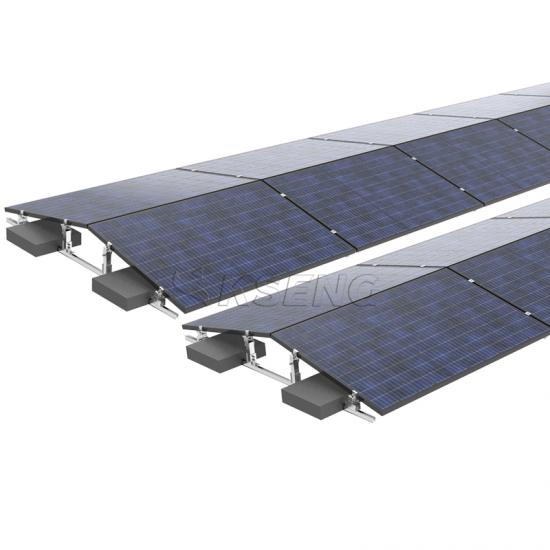What is ballasted solar racking?
May 09, 2024
Ballasted solar racking refers to a type of solar mounting system used for installing solar panels on flat or low-slope rooftops without penetrating the roof membrane. Instead of attaching directly to the roof, solar ballasted racking relies on the weight of concrete blocks, known as ballasts, to hold the solar panels in place.
 Here's how ballasted solar racking typically works:
1. Design and Engineering: Solar racking systems are designed to distribute the weight of the solar panels and ballasts evenly across the roof's surface. Engineers calculate the appropriate weight and distribution of ballasts based on factors such as wind loads, roof slope, and building codes.
2. Installation: Ballasted racking systems are installed directly on the roof surface, typically without penetrating the roof membrane. The concrete ballasts are placed on top of the racking system to secure it in place. The solar panels are then mounted onto the racking structure.
3. Adjustability: Many ballasted racking systems are adjustable to accommodate variations in roof slope or orientation. This flexibility allows for optimal positioning of the solar panels to maximize sunlight exposure and energy generation.
4. Weight Considerations: The weight of the ballasts is critical to ensuring the stability of the solar array, especially in windy conditions. Engineers carefully calculate the required weight based on factors such as wind speed and building height to prevent the panels from shifting or becoming dislodged.
Here's how ballasted solar racking typically works:
1. Design and Engineering: Solar racking systems are designed to distribute the weight of the solar panels and ballasts evenly across the roof's surface. Engineers calculate the appropriate weight and distribution of ballasts based on factors such as wind loads, roof slope, and building codes.
2. Installation: Ballasted racking systems are installed directly on the roof surface, typically without penetrating the roof membrane. The concrete ballasts are placed on top of the racking system to secure it in place. The solar panels are then mounted onto the racking structure.
3. Adjustability: Many ballasted racking systems are adjustable to accommodate variations in roof slope or orientation. This flexibility allows for optimal positioning of the solar panels to maximize sunlight exposure and energy generation.
4. Weight Considerations: The weight of the ballasts is critical to ensuring the stability of the solar array, especially in windy conditions. Engineers carefully calculate the required weight based on factors such as wind speed and building height to prevent the panels from shifting or becoming dislodged.
 The solar ballasted racking offers several advantages, including:
- No Roof Penetration: Since the mounting system relies on ballasts rather than roof penetrations, it reduces the risk of roof leaks and damage.
- Quick Installation: Solar ballast mounting racks are relatively quick to install compared to systems that require roof penetrations, minimizing disruption to the building occupants.
- Versatility: They can be used on a wide range of flat or low-slope roofs.
The solar ballasted racking offers several advantages, including:
- No Roof Penetration: Since the mounting system relies on ballasts rather than roof penetrations, it reduces the risk of roof leaks and damage.
- Quick Installation: Solar ballast mounting racks are relatively quick to install compared to systems that require roof penetrations, minimizing disruption to the building occupants.
- Versatility: They can be used on a wide range of flat or low-slope roofs.
 However, ballasted racking may not be suitable for all rooftop configurations. Factors such as roof slope, building height, wind exposure, and local building codes need to be carefully considered when designing and installing ballasted solar racking systems. Additionally, periodic maintenance and inspection are essential to ensure the continued stability and performance of the solar array.
However, ballasted racking may not be suitable for all rooftop configurations. Factors such as roof slope, building height, wind exposure, and local building codes need to be carefully considered when designing and installing ballasted solar racking systems. Additionally, periodic maintenance and inspection are essential to ensure the continued stability and performance of the solar array.


